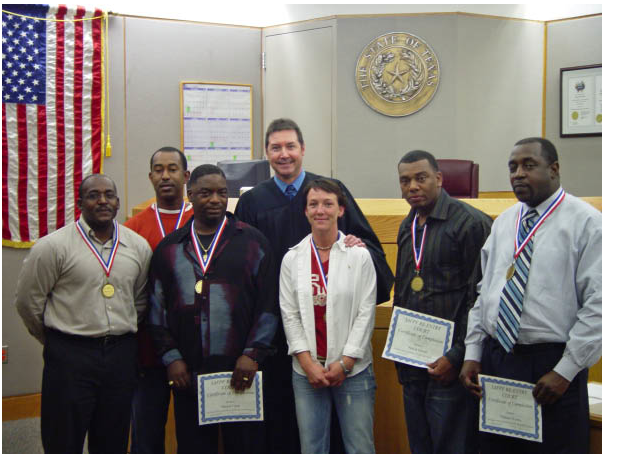Graduates of the Dallas SAFPC Program, (which can also be described as a “Front End Reentry Court”), with Judge Robert Francis.
THE BEST OF: The following article, published on Dec.13,2009, describes the success of the Dallas SAFPC program placing drug offenders, a probation program located on a prison site, that returns the offender to the community after relatively short period in custody.
The Dallas Reentry Court is a excellent example of the extraordinary innovation (and sometimes bewildering variation) among pre-entry courts, that divert offenders from a prison sentence to a probation based custodial program. What makes the Dallas SAFPF Program unique, is that its custodial segment is actually situated on prison grounds, yet program participants are segregated from the prison population, and never leave the jurisdiction of the County SAPFP Court Program.
The Texas legislature’s “4C program” provides in-custody facilities within the prison’s outer perimeter , and uses specially trained, but regular prison guards. Although there are approximately ten jurisdictions that take advantage of “4c” facilites, Dallas is by far the largest, and the only one that has a court and judge dedicated to the reentry mission. Seventeen Dallas judges sentence drug offenders to the SAFPF program, but when offenders finsh their in-custody treatment (typically 6 to 9 months), they enter a dedicated Reentry Court for monitoring, continued treatment and rehabilitative services.
Judge Robert Francis, a retired judge, works full time as the reentry court judge. He and his staff take regualr trips to the “4C” facilities to check up on Dallas based offenders. Plans are in the works to reward those who do well well in the in-custody program. Though the progam is less than a year old, 275 participants have completed the in-custody “4C” treatment program, and been released into the care and custody of Judge Francis and the Dallas SAFPF Reeentry Court, where revocations are at an extraordinarily low 5%.
Contact: [email protected]


